
2011 Energy and Mines Ministers Conference
CANADA AS A GLOBAL ENERGY LEADER: TOWARD GREATER PAN-CANADIAN COLLABORATION
INTRODUCTION
Federal, provincial and territorial governments have a key leadership role to play in establishing a principles-based approach to securing Canada’s energy future. This approach will respect the distinct constitutional jurisdictions, government authorities and circumstances that make up our regionally diverse country. The pan-Canadian approach to energy outlined here is based on solid principles, including a strong market orientation governed by effective, efficient and transparent regulatory systems.
To be
successful, a pan-Canadian approach to 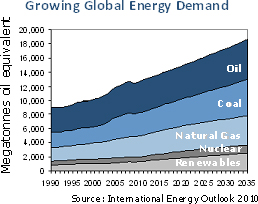 energy needs to be situated in a global
energy context that is undergoing unprecedented change. First, world energy
demand is driving higher. Emerging economies are key contributors to this
increase in demand, reflecting faster rates of growth in economic activity,
population and urbanization. In particular, the growing importance of China
to global energy markets is critical. Second, there are mounting concerns
regarding supply constraints and the need for energy security globally and
within North America.
In part, this trend is related to greater economic volatility and geopolitical
uncertainty. Third, the world is at the beginning of a longer-term transition
towards a lower-carbon economy. While fossil fuels will remain the dominant
source of global energy for decades to come, leading economies are making major
investments to diversify energy sources and position themselves as low-carbon
technology leaders.
energy needs to be situated in a global
energy context that is undergoing unprecedented change. First, world energy
demand is driving higher. Emerging economies are key contributors to this
increase in demand, reflecting faster rates of growth in economic activity,
population and urbanization. In particular, the growing importance of China
to global energy markets is critical. Second, there are mounting concerns
regarding supply constraints and the need for energy security globally and
within North America.
In part, this trend is related to greater economic volatility and geopolitical
uncertainty. Third, the world is at the beginning of a longer-term transition
towards a lower-carbon economy. While fossil fuels will remain the dominant
source of global energy for decades to come, leading economies are making major
investments to diversify energy sources and position themselves as low-carbon
technology leaders.
This document presents some of the key energy opportunities and challenges facing the country and outlines elements of greater Pan-Canadian collaboration, including a shared vision, common principles and key objectives. This proposed approach reflects the desire of federal, provincial and territorial governments to build on the strengths of Canada’s energy sector and grow its status as a global energy leader within a changing world.
AN ABUNDANT AND DIVERSE SUPPLY OF ENERGY RESOURCES
Within Canada, there is a large, unique and diverse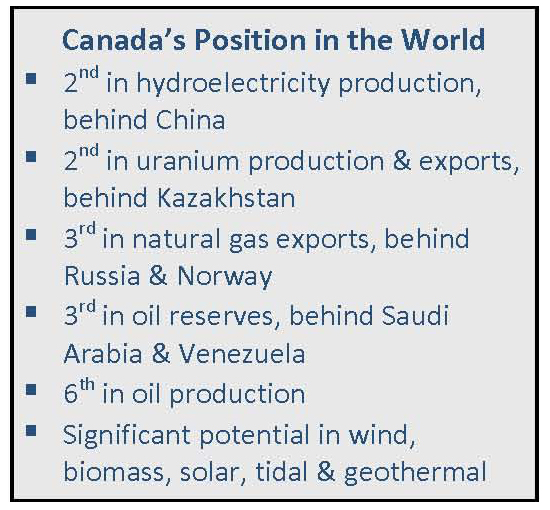
energy endowment. Canada ranks second in global production of hydro electricity. Canada is also the second largest global producer and exporter of uranium. These are both clean energy sources that are essential to economic development and efforts to address climate change. It has the world’s third largest oil reserves. It is the only OECD country with growing oil production and is the world’s third largest exporter of natural gas. Canada’s nuclear generating stations operate with strong regulatory oversight nationally and adhere to the highest safety standards internationally. We are also leaders in clean electricity with 75 percent of our power generation coming from non-emitting sources, contributing to both economic and climate change objectives. Notably, the country is well positioned to generate energy from other renewable sources such as wind, solar, geothermal, marine, and biomass. As well, Canada’s northern regions are relatively untapped, extremely energy-rich areas, with higher costs of living and where having affordable energy is a challenge. Development of these energy resources will ensure a vibrant northern economy and sustainable communities. These endowments provide an unparalleled economic advantage to secure our place as a global energy leader.
The Canadian energy sector is continually evolving, integrating new technologies and practices to improve efficiency and to develop new and unconventional sources of energy. This is aligned with global trends including a shift from conventional oil and gas to resources such as oil sands, shale gas and renewable fuels, and we will need to encourage the development of these resources and related transportation infrastructure. Similarly, technological developments such as smart grids and carbon capture and storage promise cleaner power generation in Canada. Further advancements will be made as electricity systems integrate increased volumes of cleaner fuels, including natural gas, nuclear, hydro (large-scale and small-scale), and other renewable sources. As well, significant strides are being made to improve energy efficiency and conservation. These diverse sources strengthen Canada’s and the world’s energy security. At the same time, there is recognition, in Canada and elsewhere, of the need to ensure that all sources of energy are developed and used in ways that are environmentally responsible and socially acceptable.
The energy sector is critical to our economy as 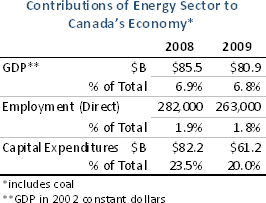 a source of employment and wealth creation. In 2009, the sector represented 6.8 percent of Canada's gross domestic product (GDP), providing direct employment for over 260,000 people. Its capital expenditures amounted to $61 billion, representing 20 percent of total new capital investment in the country. The sector represents the largest single private investor of capital and a primary driver behind foreign direct investment. It also has a positive economic impact on other industries, such as financial services, engineering services, equipment manufacturing and construction. In 2008, revenues from this sector to provincial, federal and some territorial treasuries were about $35 billion in taxes and royalties, making an important contribution to critical social programs across the country while dampening the need for government revenue derived from other sources.
a source of employment and wealth creation. In 2009, the sector represented 6.8 percent of Canada's gross domestic product (GDP), providing direct employment for over 260,000 people. Its capital expenditures amounted to $61 billion, representing 20 percent of total new capital investment in the country. The sector represents the largest single private investor of capital and a primary driver behind foreign direct investment. It also has a positive economic impact on other industries, such as financial services, engineering services, equipment manufacturing and construction. In 2008, revenues from this sector to provincial, federal and some territorial treasuries were about $35 billion in taxes and royalties, making an important contribution to critical social programs across the country while dampening the need for government revenue derived from other sources.
Regional diversity in energy resources, supply and demand is a
source of strength that continues to shape our economy. Several![]()
provinces and territories are endowed with large hydroelectric resources and are significant exporters of electricity. Others have abundant fossil fuel resources and are large producers, exporters and users of oil, natural gas and coal. Nuclear energy makes a significant contribution to the electricity system in some jurisdictions and one province is a world leader in the production of uranium. As well, there is growing development of other renewable resources, with vast potential across the country. These regional differences lead to diverse challenges but also unique opportunities.
SEIZING GLOBAL OPPORTUNITIES
Canada is one of the few countries in the world that is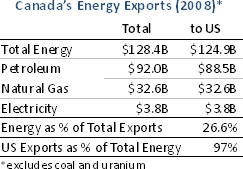 energy-rich, has a highly skilled work force and strong innovation system, and is also capable of increasing its energy production in an environmentally and economically sustainable manner. We also recognize that open markets are essential to our economic sustainability. With the International Energy Agency (IEA) projecting global energy demand to increase by 36 percent by 2035, we are well positioned to grow our status as a politically stable, competitive and reliable energy producer by maintaining a positive investment climate.
energy-rich, has a highly skilled work force and strong innovation system, and is also capable of increasing its energy production in an environmentally and economically sustainable manner. We also recognize that open markets are essential to our economic sustainability. With the International Energy Agency (IEA) projecting global energy demand to increase by 36 percent by 2035, we are well positioned to grow our status as a politically stable, competitive and reliable energy producer by maintaining a positive investment climate.
Canadian energy resources and expertise are particularly important to North American energy security. The US is our leading energy export market and will remain a strategic partn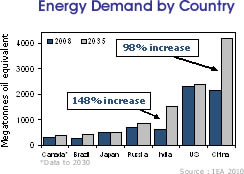 er for decades to come. In 2008, Canadian exports of electricity, oil and natural gas amounted to $128.4 billion with 97 percent going to the US. Due to the economic downturn, exports fell to $85 billion in 2009 but are now rebounding. The two countries have highly integrated electricity grids, and supply almost all of each other’s electricity imports. Notably, the electricity trade between the provinces and their neighbouring US states exceeds interprovincial transfers. Canada and the US also share an extensive oil and gas pipeline network that further shows the interconnection of our shared energy systems and the importance of energy to the broader economic partnership.
er for decades to come. In 2008, Canadian exports of electricity, oil and natural gas amounted to $128.4 billion with 97 percent going to the US. Due to the economic downturn, exports fell to $85 billion in 2009 but are now rebounding. The two countries have highly integrated electricity grids, and supply almost all of each other’s electricity imports. Notably, the electricity trade between the provinces and their neighbouring US states exceeds interprovincial transfers. Canada and the US also share an extensive oil and gas pipeline network that further shows the interconnection of our shared energy systems and the importance of energy to the broader economic partnership.
Canada’s energy sector also needs to expand its presence beyond its traditional market given the extent of changes taking place in today’s world. Global energy demand is being driven by emerging economies, led by China. The IEA indicates that China has already overtaken the US as the world’s largest energy user and is projected to consume over one fifth of world energy by 2035. Our energy resources, technologies and industry expertise provide a competitive advantage and a basis to aggressively develop new markets. Cultivating relationships with China and other emerging economies, while also developing new infrastructure to enable the transportation of energy products to diverse markets, including markets within Canada, will go a long way to growing our global energy leadership and maximizing the benefits of its energy resources for Canadians.
MANAGING GROWTH AND CHANGE AT HOME
As with the rest of the world, our energy demand is expected to increase in the coming decades, albeit at a slower rate. According to the National Energy Board’s 2009 Reference Case Scenario, end-use energy demand in Canada is projected to increase at an average of 0.7 percent per year to 2020. This is considerably lower than the historical rate of 1.6 percent since 1990.
Federal, provincial and territorial governments are committed to improving energy efficiency. While Canada’s per capita energy use is high amongst OECD countries, this is related to our cold climate, vast geography, a widely dispersed population and an energy-intensive resource-based industrial sector. With these challenges, continued improvement in energy efficiency is critical to the competitiveness of the economy and the Canadian standard of living.
Federal, provincial, territorial and local authorities have been making concerted efforts to promote energy efficiency and conservation across the country (e.g., improved building codes, use of smart meters, more stringent energy efficiency product standards, investments in integrated community energy systems). Real gains have been made in slowing the demand for energy. The Canadian economy has experienced an 18 percent improvement in energy efficiency between 1990 and 2008. Canada was recently rated as one of the top three IEA countries for fully implementing a range of energy efficiency policies and programs. However, more action on this front is required to help Canadians reduce consumption and save money, while decreasing the environmental impacts associated with energy use.
At the same time, changes in Canada’s industrial and ma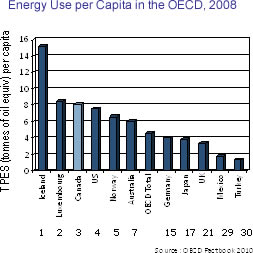 nufacturing sectors are shaping the future of energy demand. Outside of the upstream fossil fuel and electricity sectors, growth in industrial output has been accompanied by structural shifts to less energy-intensive industries and by substantial efficiency gains within industries such as metal mining, chemical production, and petroleum refining. In fact, industrial energy intensity decreased by 15 percent from 1990 to 2008. All sectors will need to continue to invest in new equipment and machinery, clean technologies and more efficient operations to realize further improvements in energy efficiency, conservation and savings – knowing that, in today’s global economy, this will increase competitiveness.
nufacturing sectors are shaping the future of energy demand. Outside of the upstream fossil fuel and electricity sectors, growth in industrial output has been accompanied by structural shifts to less energy-intensive industries and by substantial efficiency gains within industries such as metal mining, chemical production, and petroleum refining. In fact, industrial energy intensity decreased by 15 percent from 1990 to 2008. All sectors will need to continue to invest in new equipment and machinery, clean technologies and more efficient operations to realize further improvements in energy efficiency, conservation and savings – knowing that, in today’s global economy, this will increase competitiveness.
MEETING THE CHALLENGE
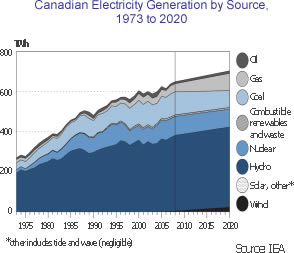
Diversifying our energy sources, meeting growing demand at home and securing access to global markets will require significant investment over the coming decades. A major challenge is the aging energy infrastructure in Canada. Going forward, it is expected that hydro will remain the dominant source of power generation, with nuclear power remaining a significant source of electricity and both natural gas and other renewable energy sources increasing in importance.
With respect to pipelines, it is estimated that industry will invest $43 billion in expansion over the next 15 years. If the Alaska and Mackenzie pipelines are included, total investment could be as large as $100 billion, based on latest estimates. As oil and gas development in Canada expands to new areas, additional pipeline infrastructure will be required in Western and Eastern Canada.
Notably, there are also concerns about the physical security of Canada’s energy systems which will impact infrastructure investments and require closer coordination amongst industry and government players to mitigate risk and enhance reliability and safety.
The massive scale of upcoming energy investments provides an opportunity to sustain economic growth while also supporting the transition to a lower-carbon future. Investments in the development of all new energy sources, as well as energy transportation infrastructure, will present challenges around public acceptance related to impacts on energy costs and the environment. These projects will also require an efficient and effective regulatory approach, ongoing environmental protection and public and stakeholder engagement, including with Aboriginal peoples. In particular, efficient, effective, transparent and market-oriented regulation will provide greater ![]() certainty for investors and will support effective stewardship of the resources.
certainty for investors and will support effective stewardship of the resources.
Innovation is central to developing clean energy technologies and is critical to improving competitiveness and enabling the federal government to meet its Copenhagen Accord commitment of reducing GHG emissions by 17 percent by 2020 relative to 2005 levels. Clean energy technology has the potential to transform Canada’s energy systems. It is an important dimension for improving environmental performance and facilitating a longer-term shift to a lower-carbon future. At the same time, it is an emerging industry with significant global and local market opportunities, and is a means for generating wealth and high-quality jobs. An assessment of our clean tech capacity shows strengths across the country and in a number of areas including carbon capture and storage (CCS), advanced materials for vehicles, electric vehicles, gas turbines and photovoltaics. We have a solid research and innovation base upon which to build, yet there are also critical challenges to address. Greater collaboration amongst federal, provincial, territorial and local authorities will help to ensure that we become global leaders in the development and use of clean energy technology. The Canada-US Clean Energy Dialogue (CED) is another way by which we are deepening our approach to clean energy technology and innovation.
MOVING FORWARD
Higher global energy demand and the evolution toward a lower-carbon economy are drivers shaping today’s world. In Canada, energy makes a critical contribution to the wealth and well-being of all Canadians. Going forward, there are significant opportunities to strengthen our energy systems and to capitalize on rising global demand for energy and clean energy technology. As well, major investments in our energy sector in coming years can make a critical contribution to Canada’s transition to a lower-carbon future.
Developing our energy resources has benefited all regions of the country and contributed to our prosperity. Canadians need to better understand the energy sector, its supply chain and the contributions it makes to the Canadian economy. They also need to learn more about the economic and environmental benefits associated with being more efficient users of energy. At the same time, the world also needs to know that we, as energy leaders, take environmental stewardship and energy development seriously.
TOWARDS GREATER PAN-CANADIAN COLLABORATION
We have a proud record of energy development and environmental stewardship. In today’s changing world, growing our status as a global energy leader will require leadership and federal, provincial and territorial cooperation. The proposed vision, principles and objectives outlined below provide direction for the development and use of our vast resource endowment while transitioning to a lower-carbon future.
Shared Vision
To seize the tremendous opportunities available to our energy sector and address challenges involved in developing and using our energy resources, Energy Ministers will work together toward realizing a shared vision that:
Canada is a recognized global leader in secure and sustainable energy supply, use, and innovation.
Principles
The following principles will guide our action:
- Acknowledge the need for an adequate and reliable supply of energy.
- Recognize the importance of socially and environmentally responsible development, transportation and use of energy.
- Maintain a market-oriented approach to energy policies governed by effective, efficient and transparent regulatory systems.
- Recognize that federal, provincial and territorial cooperation is essential while respecting distinct constitutional jurisdictions and government authorities.
Key Objectives
To achieve this vision, the following key objectives have been identified:
Responsible Energy Supply
- To work in collaboration with industry, communities, stakeholders and First Nations to promote socially and environmentally responsible development, use and transportation of energy.
- To provide regulatory efficiency, policy clarity and predictability to the public, stakeholders and investors regarding the development of energy resources in Canada.
- To collaborate on a long-term transition to a lower-carbon economy.
Economic Prosperity
- To diversify and expand global markets for Canadian energy products and services.
- To provide energy security for Canadians through a diversity of supply and open markets.
- To enhance inter-provincial collaboration in the development and commercial trade of Canadian energy resources.
Efficient Energy Use
- To improve energy conservation and the efficient use of energy in Canada.
- To collaborate on the creation of codes, standards and best practices required for energy efficient houses, buildings and communities.
- To leverage improved energy efficiency into opportunities to grow new businesses and improve the international competitiveness of Canadian businesses.
Knowledge and Innovation
- To accelerate the development of clean energy technologies, innovation, investment and a skilled work force, supported by improved collaboration with industry, research organizations and governments.
- To collaborate and share knowledge and experience obtained in the development and implementation of energy policies within federal, provincial and territorial governments.
- To engage Canadians in an energy dialogue to improve awareness and understanding on energy development and use.
Action Plans
Action plans are under development, focusing on priority areas for energy sector collaboration amongst federal, provincial and territorial governments. The action plans shall identify common issues on which the federal, provincial and territorial governments could agree to cooperate on a voluntary basis through subsequent agreements. Federal, provincial and territorial working groups will report annually through Deputy Ministers to Ministers at the Energy and Mines Ministers Conference on progress made under the action plans.
CONCLUSION
How energy is supplied and used in Canada is critical to the prosperity and the well-being of Canadians across the country. The decisions made today – in resource development, energy infrastructure investments, resource use, technology development and energy efficiency – will shape our future prosperity. Establishing a shared vision, common principles and objectives will strengthen the efforts of all governments in working together to grow the energy sector by building on existing advantages, overcoming challenges in an uncertain world, and planning for a transition to lower-carbon economy.